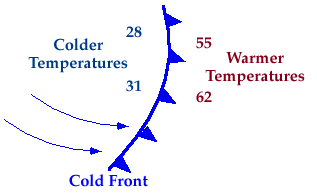From The Developers...
This opens up an additional menu of cold front related topics.
So the current page is now "definition" within "Example: Cold Fronts".
The items available in the "Example: Cold Fronts" menu
include a definition (current page), details about cold
fronts and precipitation, plus the importance of cold fronts in cyclones.
|
Cold Front
transition from warm air to cold air
A cold front is defined as the transition zone where a cold air mass
is replacing a warmer air mass. The air behind a cold front is colder
and generally drier than the air ahead of it.
In the picture below, temperatures ahead of the cold front are
55 and 62 degrees while behind the front
temperatures are lower, 31 and 28.

If you were standing outside and a cold front passed through,
the air would become cooler and drier than it was before.
Occasionally, the temperature can drop as much as 15 degrees in an hour after
a cold front comes through.
Symbolically, a cold front is represented
by a solid blue line with triangles along
the front pointing towards warmer air.
The triangles indicate the direction in which the front is moving.
On most weather maps however, a cold front is represented by simply a solid
blue line.


Efficient Navigation
|
|

precipitation
|
|



